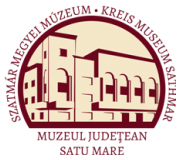Marta, Liviu (szerk.): Satu Mare. Studii şi comunicări. Seria arheologie 26/1. (2010)
János Németi: Acâs - Râtul lui Veres (Veres-rét). The Late Bronze Age settlement
János Németi the area of the sections IV and VII was identified a section of 1 m wide, probably one of those investigated by N. Iercoşan in 1983. Presentation of the 2000 year discoveries This presentation deals with Bronze Age discoveries. Pit No. 2 of SII. (Cas. CSV.), pit content: 1. large-sized, tub-shaped vessel made of coarse paste, tempered with crushed shards; smooth on the outside; thick, grey body with dark inclusions. The vessel is decorated by six crested handle buttons and six crested knobs. The vessel is fragmentary, but the drawing depicts it restored. Dimensions: rim diameter of 72 cm; 48 cm high; base diameter of 23 cm, 24 cm in body diameter. No. of inventory 29 791 (Pl. XII/1). This vessel occurred scanty among the Late Bronze Age discoveries, but it compares well with the vessel found at Petea-Csengersima6. 2. large-sized fragmentary vessel (the base and the lower part were corrupted and refired); brown-reddish clay with large, grey spots. The vessel has a broad everted rim, cylindrical neck, well distinguished from the slightly bulged body. The vessel is made of semi-fine paste, tempered with fine sand. The neck is decorated by small, tapered buttons; the body is provided with fluting knobs, semi-circular, framed by vertical protruding cordons. This decoration comes symmetrically recurrent, namely four knobs and four protruding cordons. Dimensions: 26 cm of the rim diameter, 36-40 cm in height (?); base diameter of 20 cm (?). No. of inventory 28 792 (Pl. X/3). This amphora type of vessel with two broad handles is well known among the discoveries made at Hajdubagos/Pişcolt-Cehăluţ7, this variant without handles appeared at Berveni8, Valea lui Mihai - Groapa Noua de Lut (unpublished discovery), Tăşnad-Sere (parking), a discovery of 2009 gr. 193/A. It compares well with Petea-Csengersima9, Nyíregyháza - Úr-csere10. 3. fragment of a bowl with inverted rim and small knobs coming out of the rim, laid symmetrically. Semi-fine paste; brown-reddish with grey spots; tempered with fine sand. Dimensions: 12 cm in rim diameter. No. of inventory 28 793 (Pl. XI/3). This type of bowl is frequent in the Late Ottomany culture and appears under the influence of the Tumulus culture from Carei-Bobald11. The bowl-tureen type of vessel appears at Berveni, in the Hajddbagos/Pişcolt- Cehăluţ culture12, Tăşnad-Sere - parking (unpublished). 4. fragment of a vessel foot (jar?), slightly concave; made of homogeneous paste; tempered with fine, brown-reddish sand. Dimensions: base diameter of 10 cm; No. of inventory 28 794, (Pl. X/5). 5. fragment of a portable cooking vessel; brick-red clay with black inclusions; made of coarse paste tempered with crushed shards; rim diameter: 40 cm; No. of inventory 29 795 (PI. XI/5); it is a frequent vessel among the discoveries made at Pişcolt-Cehăluţ. 6. rim fragment of a large-sized storage vessel; everted and flat; made of semi-fine paste; tempered with river sand; orange clay; re-fired; decorated with horizontal, narrow fluting on the outside, below the rim; No. of inventory 28 796, (PI. XI/1). 7. round, stone bowl, probably used for crushing pottery (crushed shards); maximum diameter: 6,2 cm, No. of inventory 28 797. 8. fragmentary bowl with slightly lobate rim; made of fine paste; tempered with sand; orange on the inside and on the outside; burnished slip on the outside; decorated by lime inlays. The lobate rim is crested; the body is divided by vertical and horizontal stripes that comprise of incised circles framed by two incised lines filled with parallel lines in-between. The vessel base is decorated by smaller circles placed cross-like. This is a recurrent motif on the vessel body and the space in-between the horizontal stripes is decorated by spiral ends. The vessel was made with special care. Dimensions: height: 16 cm; rim diameter: 21 cm (?); base diameter: 9 cm. No. of inventory 28 798 (Pl. X/6). Bowls with inverted and lobate rim already appeared in the Ottomany 6 Marta 2009. PI. 40/16 7 Németi 2009, fig. 2/1-3; Idem 2009a, Pl. 1/1-3 8 Németi 1990, fig. 1/7 9 Marta 2009. PI. 16/2 10 Bejinariu et col. 2009, Pl. IV/1, V/3, IX/1; Idem 2009, Pl. IV/4, VII/3, XV/1 11 Németi-Molnár 2007, 234 12 Németi 1990, fig. 1/9 270
